This vegan caramel cake uses my homemade vegan salted caramel in the cake, frosting and the drip to make it the ultimate treat for the caramel lover in your life. This cake is super moist and sticky, almost like mud cake, and coated in a rich caramel buttercream. It is also completely dairy-free and vegan!
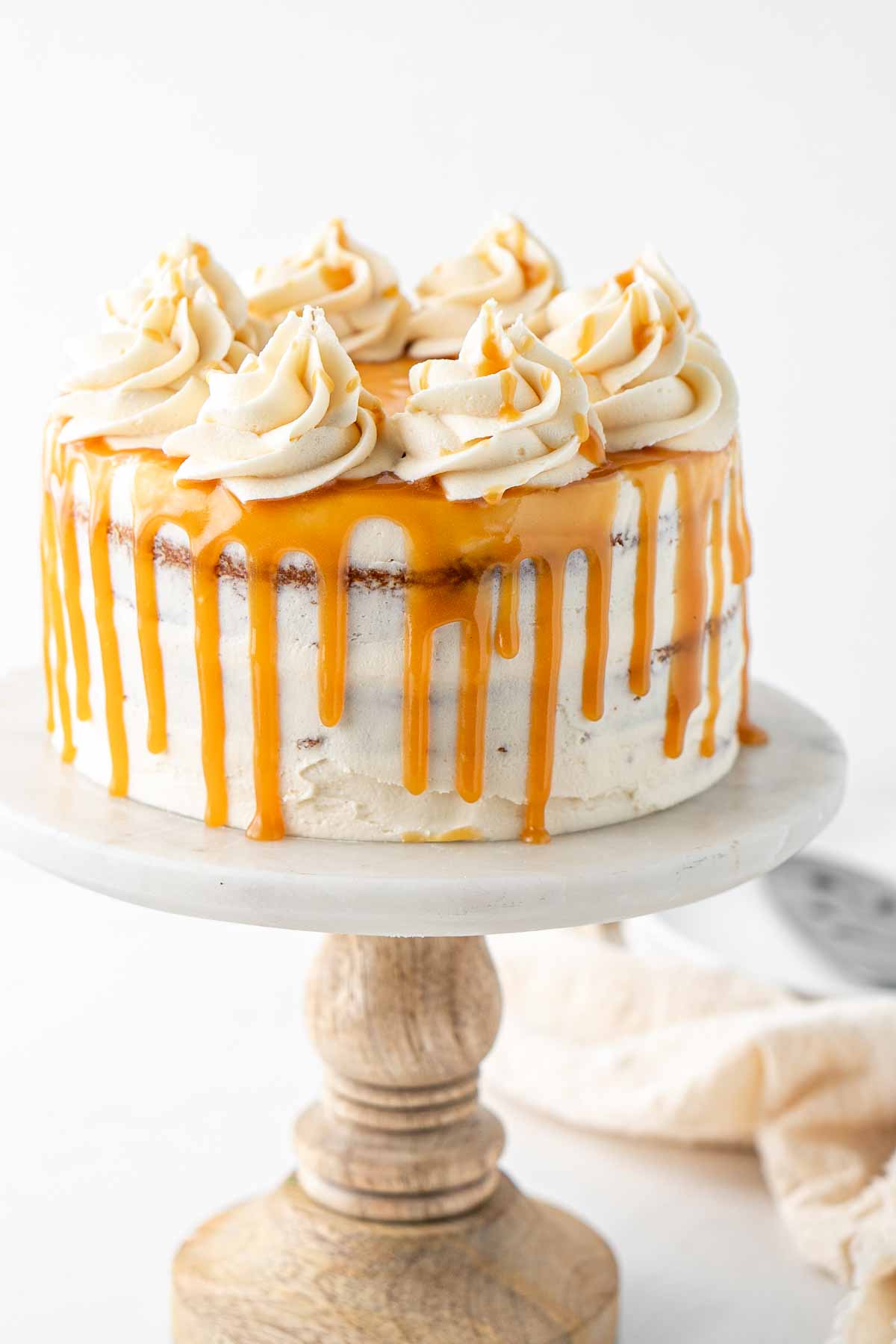
Have you made my vegan salted caramel yet? If not you are definitely missing out as it is eat out of the pot while it’s still too hot good. Plus, it’s such an easy recipe to make using simple ingredients and a great thing to keep on hand to elevate basically all desserts.
If you are a lover of salted caramel sauce, then this cake is the perfect recipe for you. You’ll need close to a full batch for the cake if you’re wanting to go all out with the drip, but any leftovers can be stored in the fridge or just used to drizzle over the top of each slice, because more caramel anyone?
In the interest of not having the longest recipe ever in this post, I haven’t included the instructions for making the caramel sauce, so you are going to want to jump over to my recipe for vegan salted caramel sauce and make that first, otherwise you can use any caramel sauce you like.
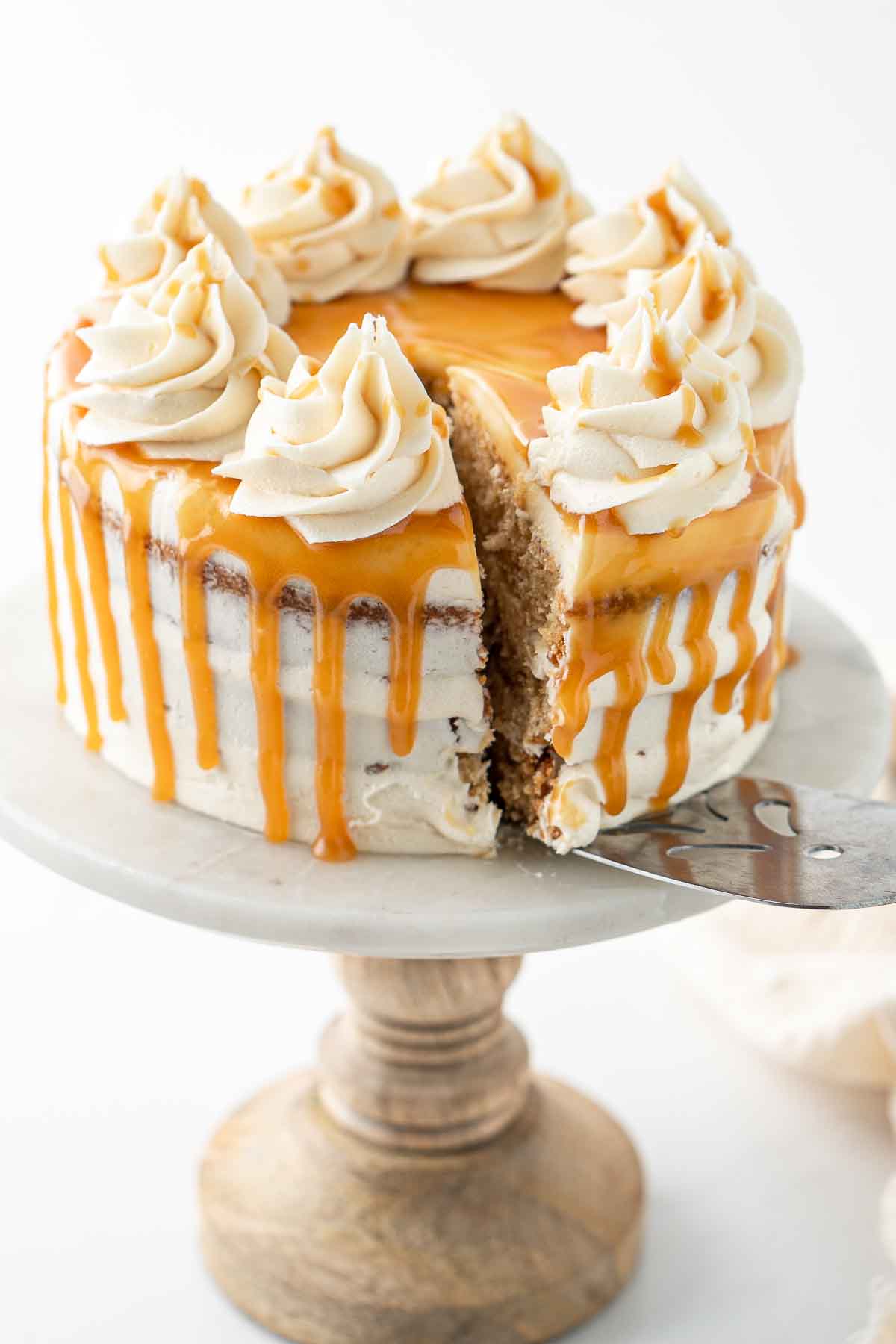
I like to use salted caramel as I find it gives a nice balance of flavour as this cake is quite sweet, however if you’re not a fan of the saltiness, simply reduce the amount of salt in your sauce to keep it as a traditional caramel.
This is a vegan cake and with the addition of the caramel into the batter it becomes quite dense and sticky – almost like mud cake.
In order to get this texture we have reduced the amount of leavener in this recipe so don’t expect the layers to rise too much. I’ve made this cake as a 3 x layer 6 inch cake, but if you want thicker layers you can just keep it as 2 layers and increase the baking time slightly.
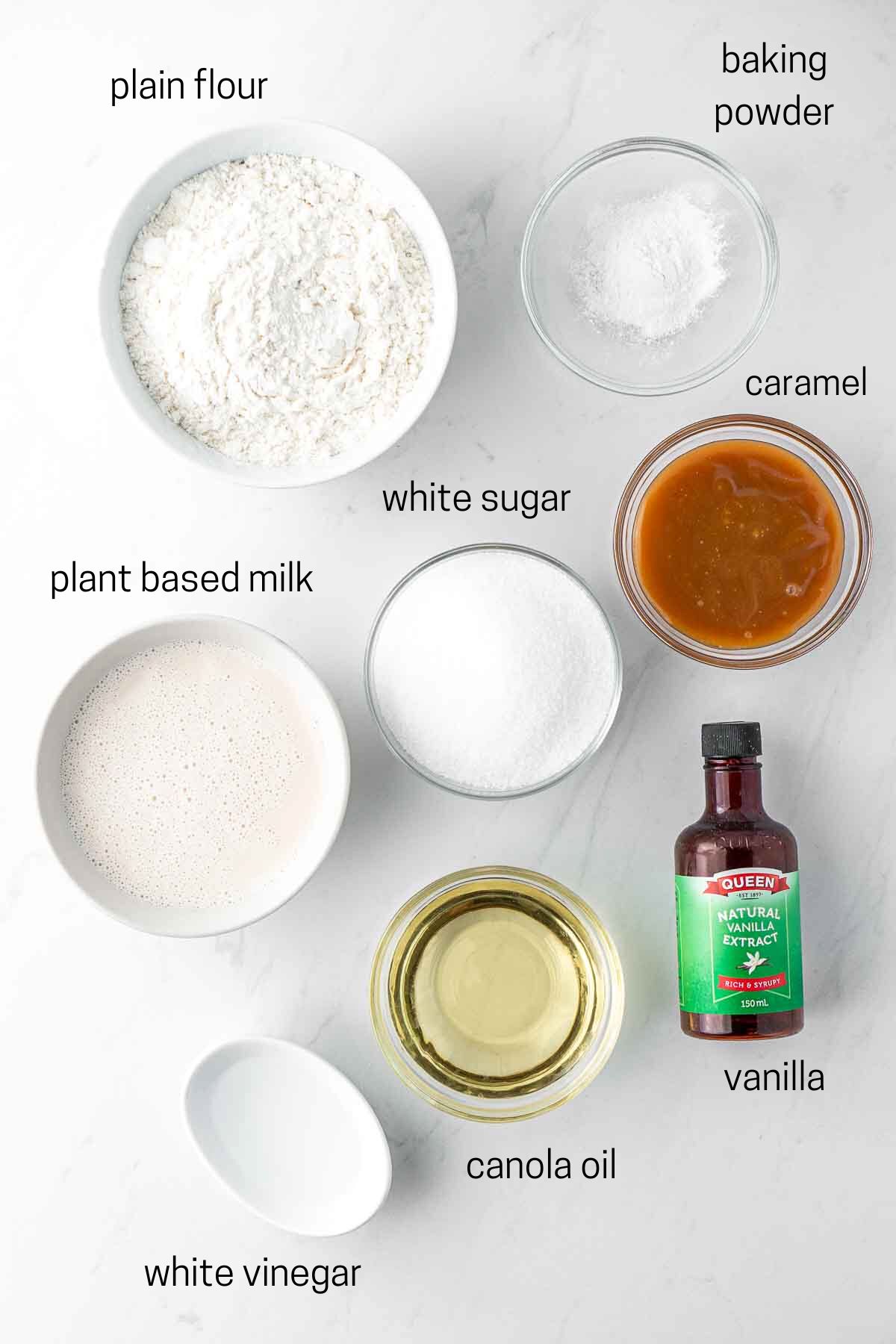
Key Ingredients
Like most of my vegan cake recipes, this one uses some basic pantry ingredients, but the secret really is in the caramel sauce!
- Dairy-free milk – I like to use oat milk or almond milk to bake with as I find it has a neutral flavour and produces a nice texture, but soy milk is also a great option. I wouldn’t use coconut milk as it will change the flavour of the cake.
- White vinegar – this is added to the dairy-free milk to create a vegan ‘buttermilk’ which helps keep this cake nice and soft. Its the key to our vegan cakes not being too dense.
- White sugar – for sweetness but we’re also using white sugar instead of brown sugar to ensure the cake layers have enough structure for layering.
- Vanilla – to enhance the flavour of the cake.
- Canola oil – to provide moisture and a soft crumb. You can use any flavourless oil in this cake.
- Plain flour – also known as all purpose flour in the US. I haven’t tried this cake with a gluten free alternative.
- Baking powder – helps the cake rise by creating air bubbles in the batter, resulting in a light and fluffy texture.
- Vegan salted caramel sauce – the key to the flavour, we’re adding some of the sauce straight into the batter which is going to give it a sticky and rich flavour. You can use regular caramel sauce or salted – whichever you prefer.
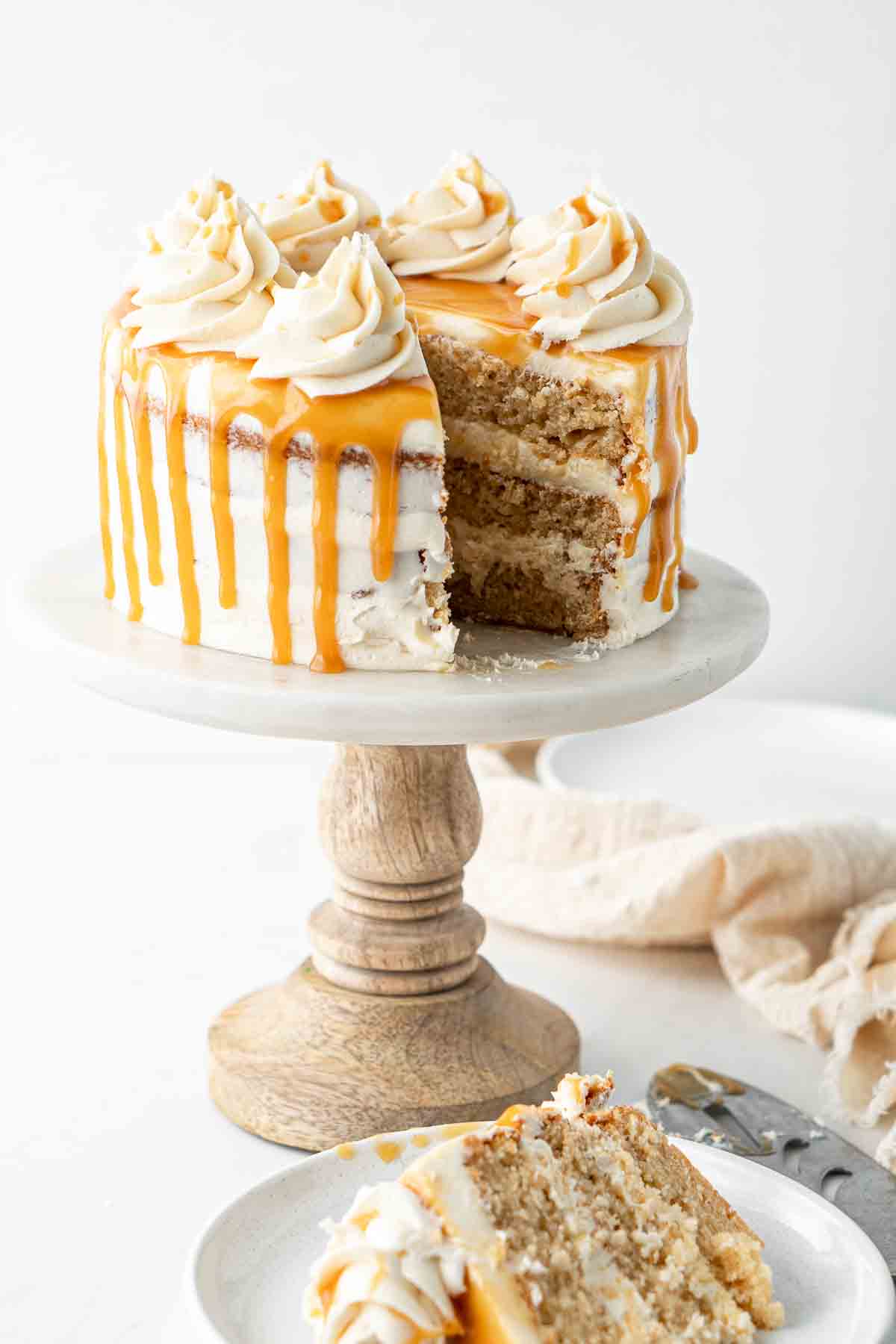
How to make the vegan caramel cake
This is a super simple cake recipe, and you don’t really need a lot of equipment, just a whisk and a couple of bowls plus 3 x 6 inch round cake tins that have had the base lined with baking paper and a light spray of cooking oil.
We are using a homemade buttermilk for this recipe as while it’s a dense, sticky cake, we still want a soft crumb. The use of the homemade buttermilk and the oil will help keep things light and delicate while remaining super moist.
Make your buttermilk using any dairy-free milk and mixing through the vinegar.
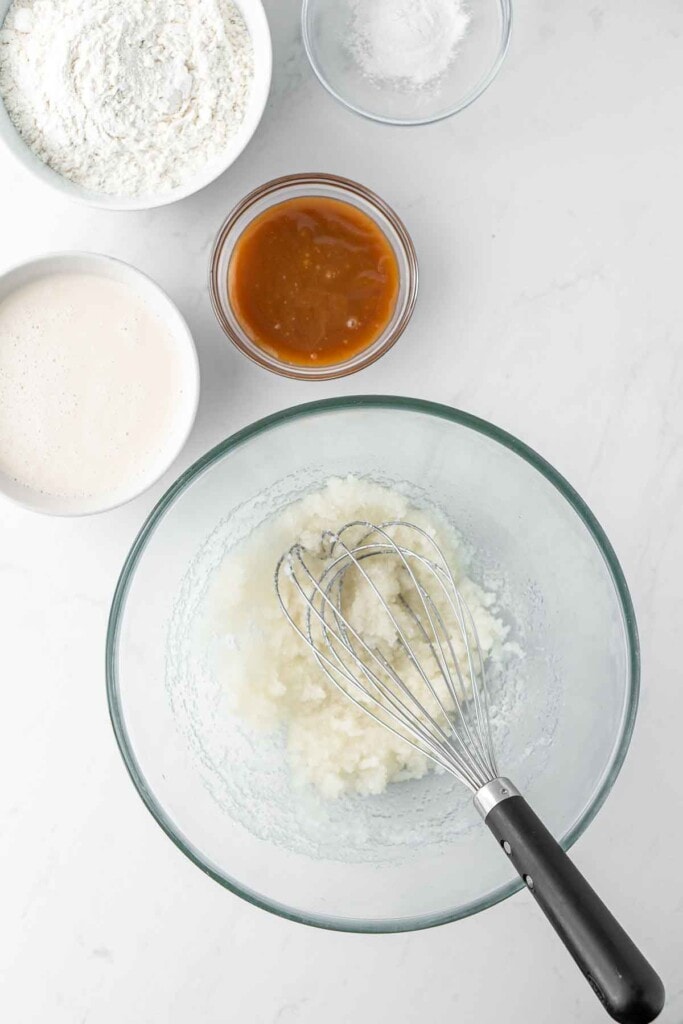
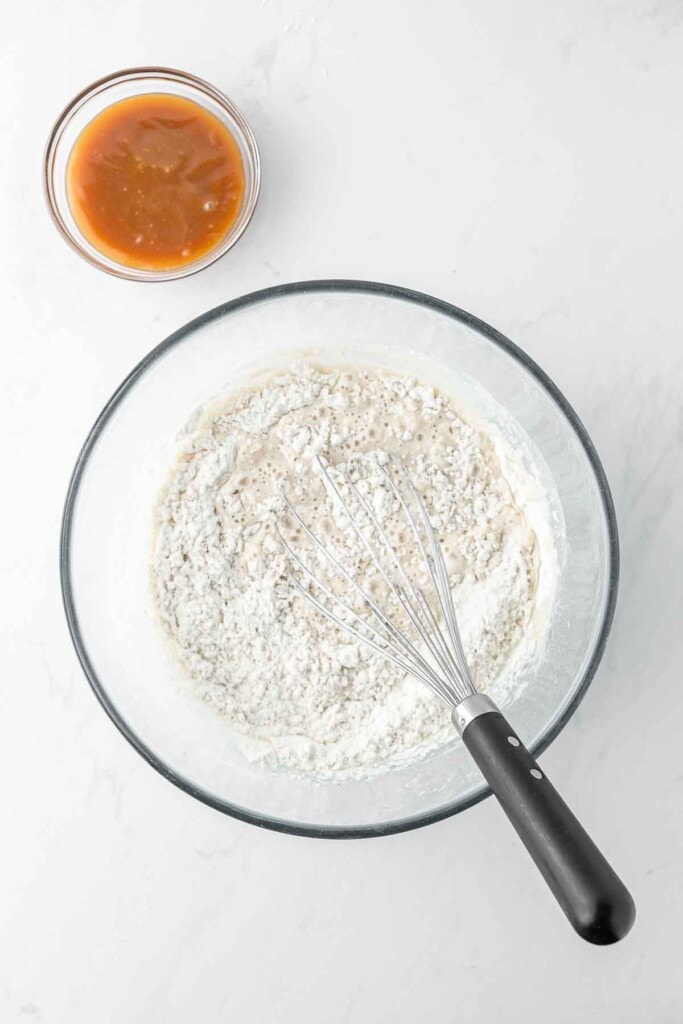
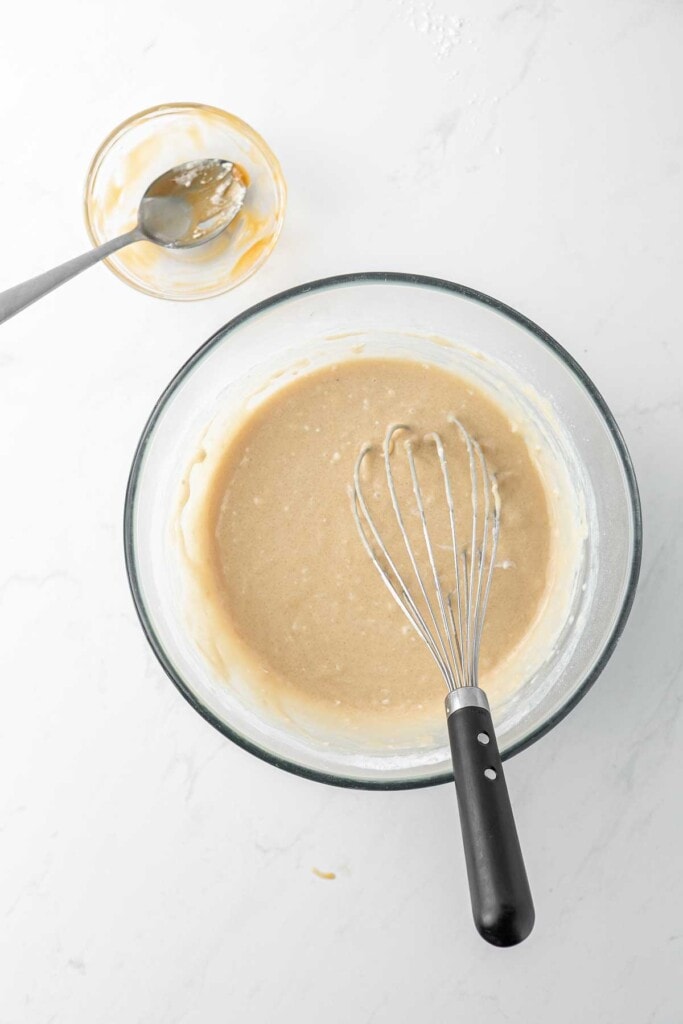
Mix up your wet ingredients in one bowl and your dry ingredients in another. Then alternate adding the buttermilk and dry ingredients to the wet ingredients until a thick batter forms. Finally mix through your caramel sauce. You want to make sure the caramel is at room temperature so that it mixes through the batter completely.
Split the batter between your prepared cake pans and bake until just cooked through. Insert a toothpick to determine if the cake is cooked or not.
Let the cake layers cool in their pans for 10 minutes before turning out onto a wire rack to cool completely before frosting.
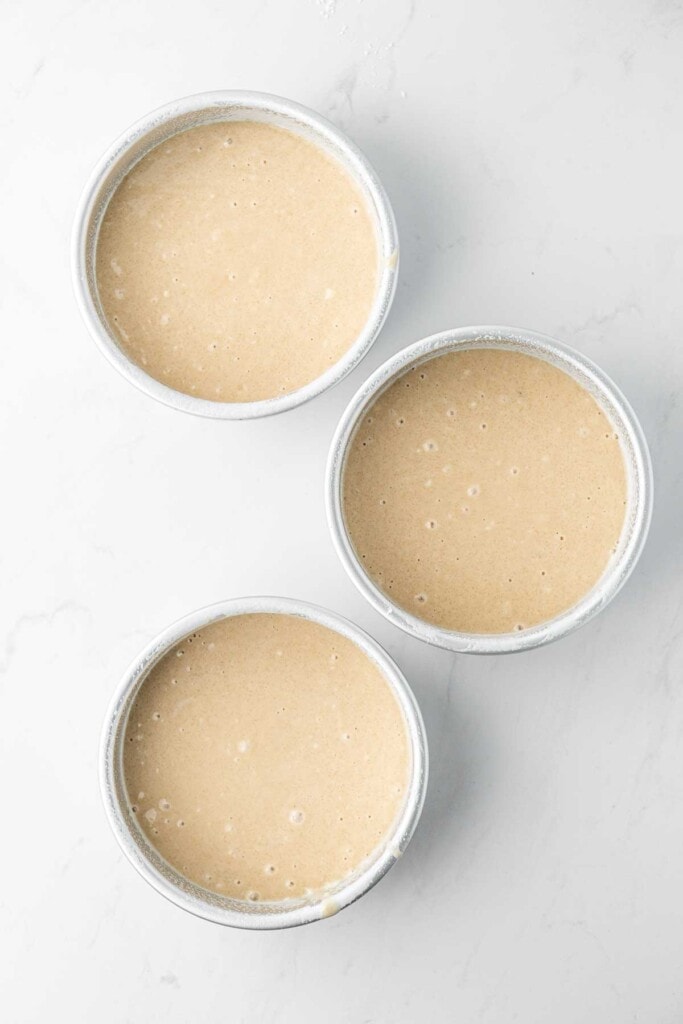
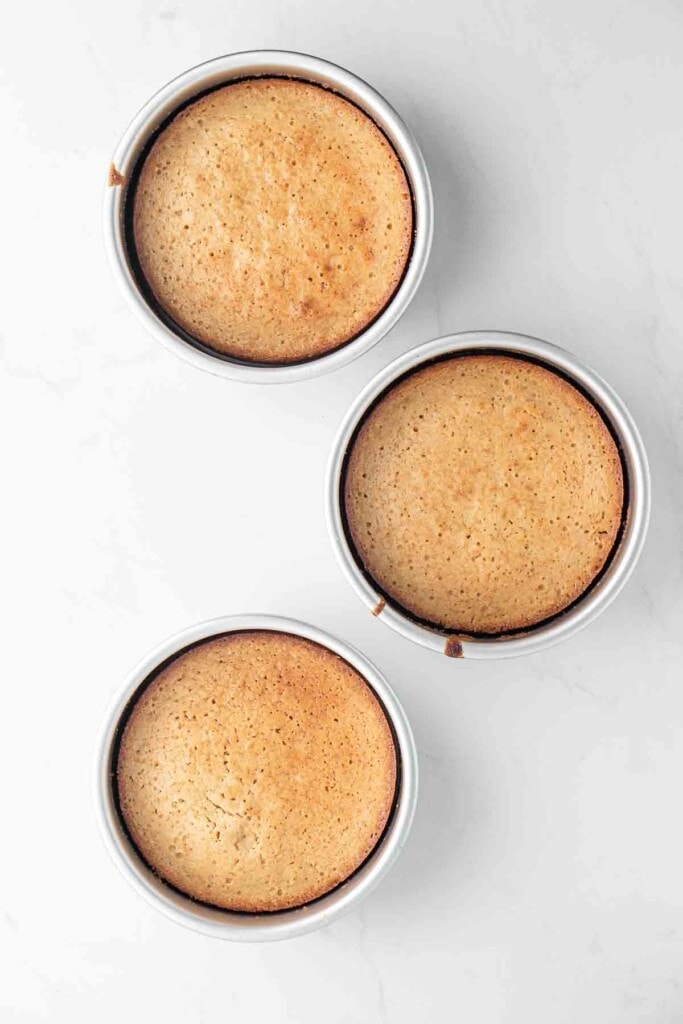
Assemble the cake!
The frosting is based on my vegan vanilla buttercream but with the addition of the salted caramel sauce. I didn’t add any additional salt, but if you want more of a salted caramel flavour to your cake, you can add some additional salt to taste.
To ensure smooth sides, I like to start with a crumb coat and then chill the cake in the fridge before finishing.
To do this, assemble the cake by placing a small amount of the buttercream on a cake stand and placing the first cake layer down. Add enough frosting to thickly cover the layer and add the second cake layer. Add more frosting, then the final cake layer upside down so the top of the cake is flat. Add more frosting to the top and side of the cake and use a cake scraper or knife to smooth out the edges and remove any excess frosting.
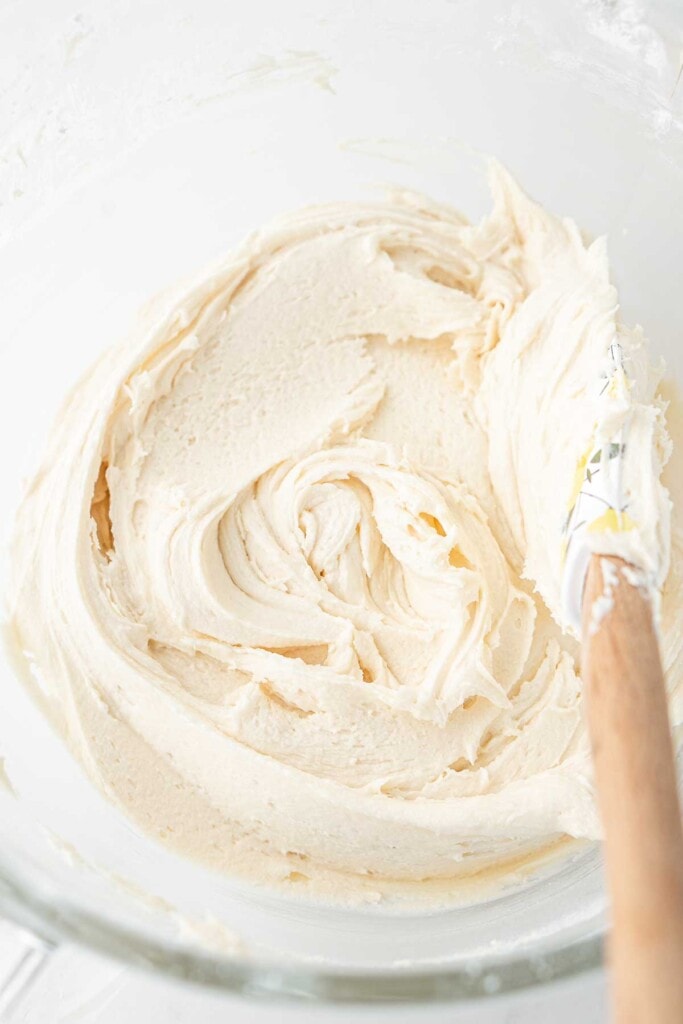
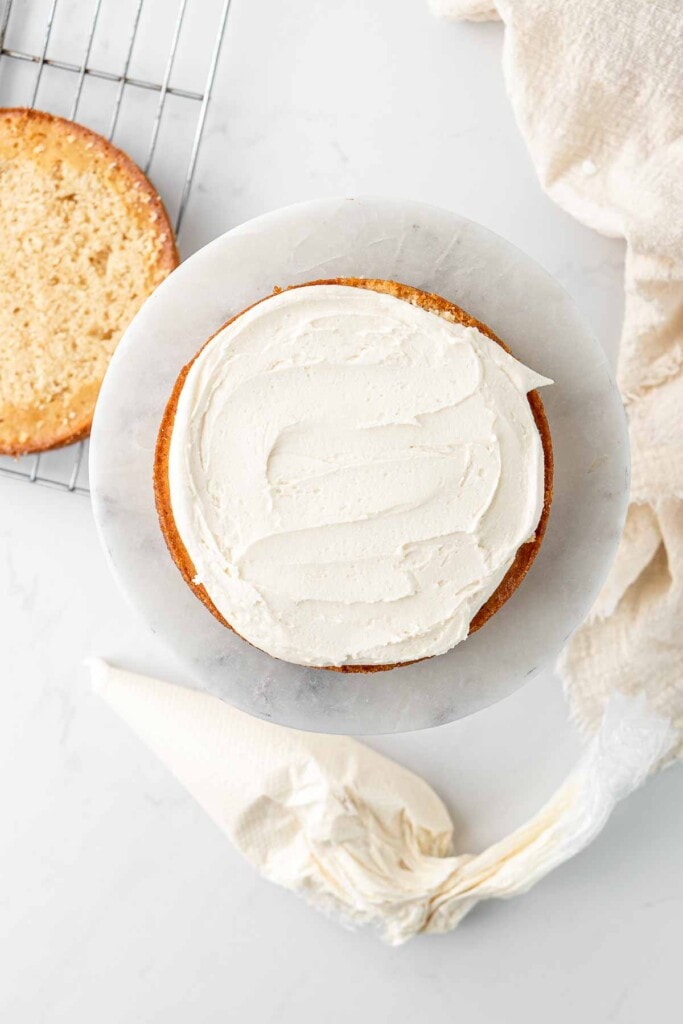
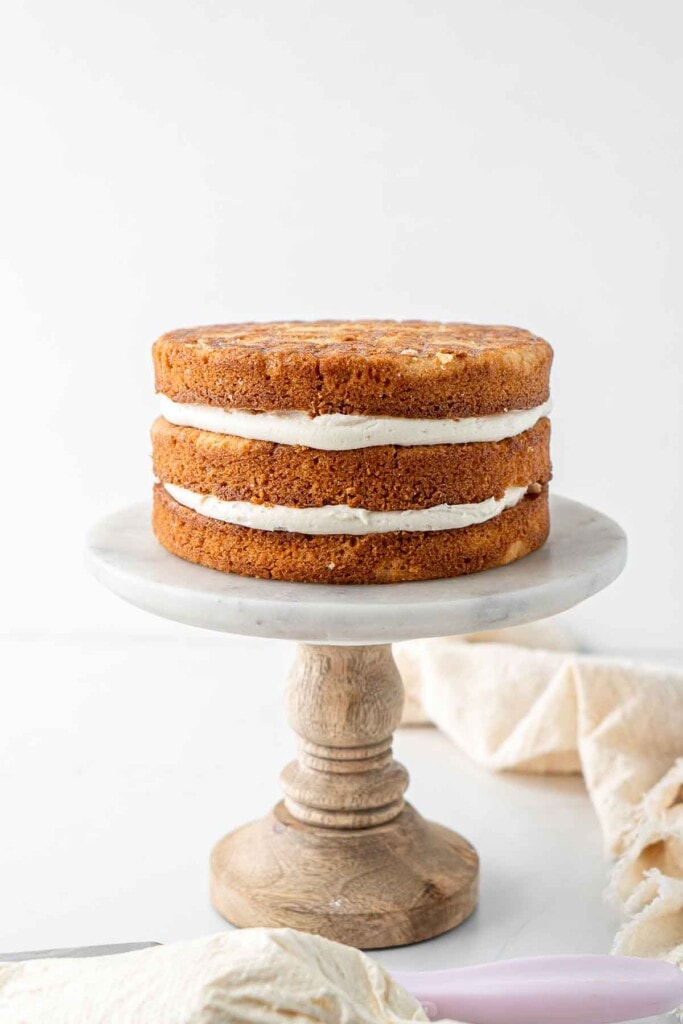
This will be your crumb coat which literally means a coating of frosting to capture and secure all cake crumbs to avoid having them ruin your finish. Place the cake in the fridge for 30-60 mins to chill.
Once the cake is cold, you can add another layer of buttercream to the tops and sides and use a cake scraper or knife to smooth out the edges if you’re wanting the outside to be completely frosted and smooth. Don’t worry if you can’t get it 100% smooth, it takes practice and patience, and if I worried about it being perfect I’d never finish a cake!
For this cake, as it’s quite rich, I opted to not add the additional layer of buttercream and kept it more ‘naked’ style which I think gives it a more rustic look.
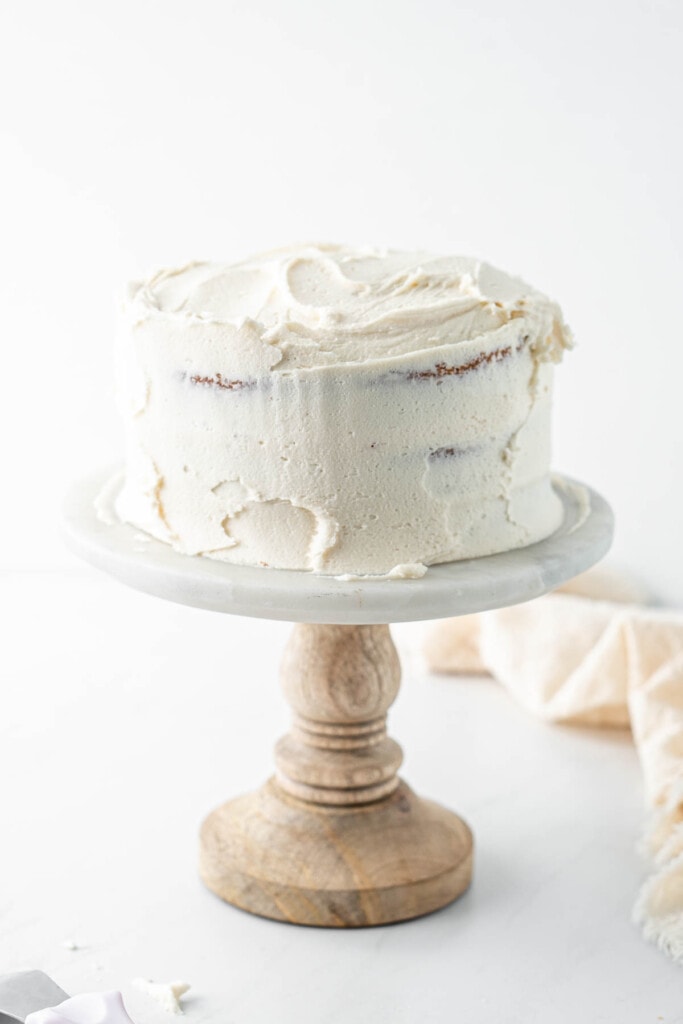
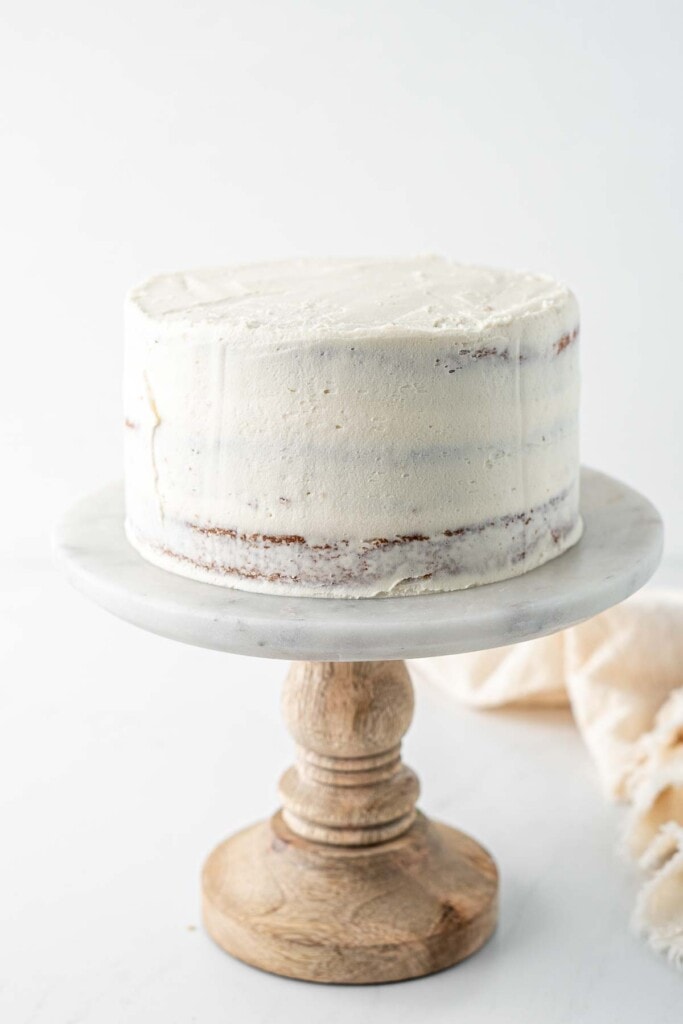
Chill the cake again before adding the caramel drip. Unlike a chocolate ganache drip, the caramel doesn’t like to stop dripping so it will slowly continue to drip down the sides. Because of this, you want to make sure your caramel is nice and thick – probably thicker than you first think.
If your caramel is too thin, you can leave it in the fridge to thicken. If it’s been in the fridge and is too thick, you can put the jar in a bowl of warm water until you get the right consistency.
I like to use a squeeze bottle for control with my drip, but you can just use a teaspoon and a steady hand if that’s all you have. Drip a small amount of the caramel down the side of the cake and watch it fall. This will give you an idea of how much you need to use per drip as you move around the cake.
Once the drips are complete, coat the top of the cake with more caramel sauce. Finally, finish the cake by piping on any excess buttercream. I used a 1M tip for mine.
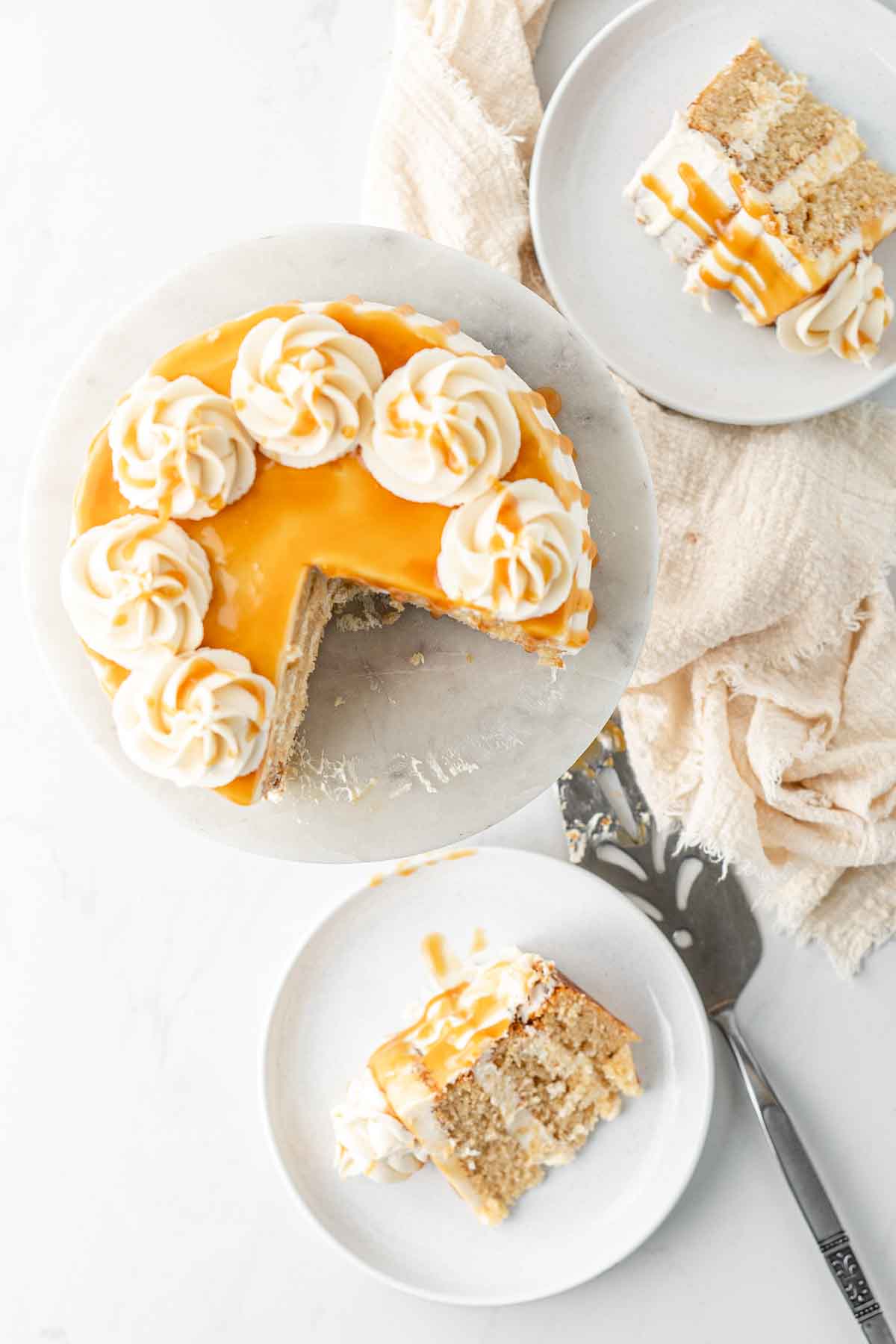
My top tips!
- Make sure to work with a cold cake when decorating, as it will be a lot easier. Also chill the cake before serving as this will allow for much cleaner slices.
- If you want to get better at smoother cake sides, invest in a cake scraper as you’ll never get the same results just using a knife.
- Do some practise drips before doing it on the cake to ensure your caramel is the correct consistency.
- To break up the steps, you can make the caramel ahead of time. I also like to bake the cakes and do the crumb coat the day before serving, and then just finish decorating the day of serving.
- The cakes are delicate, so make sure to let them cool first in the pan before turning them out otherwise they may fall apart (speaking from experience).
- Use a knife to gently level the cakes if they have domed in the oven as this will allow you to have nice flat, even surfaces and help ensure your cake doesn’t start to lean.
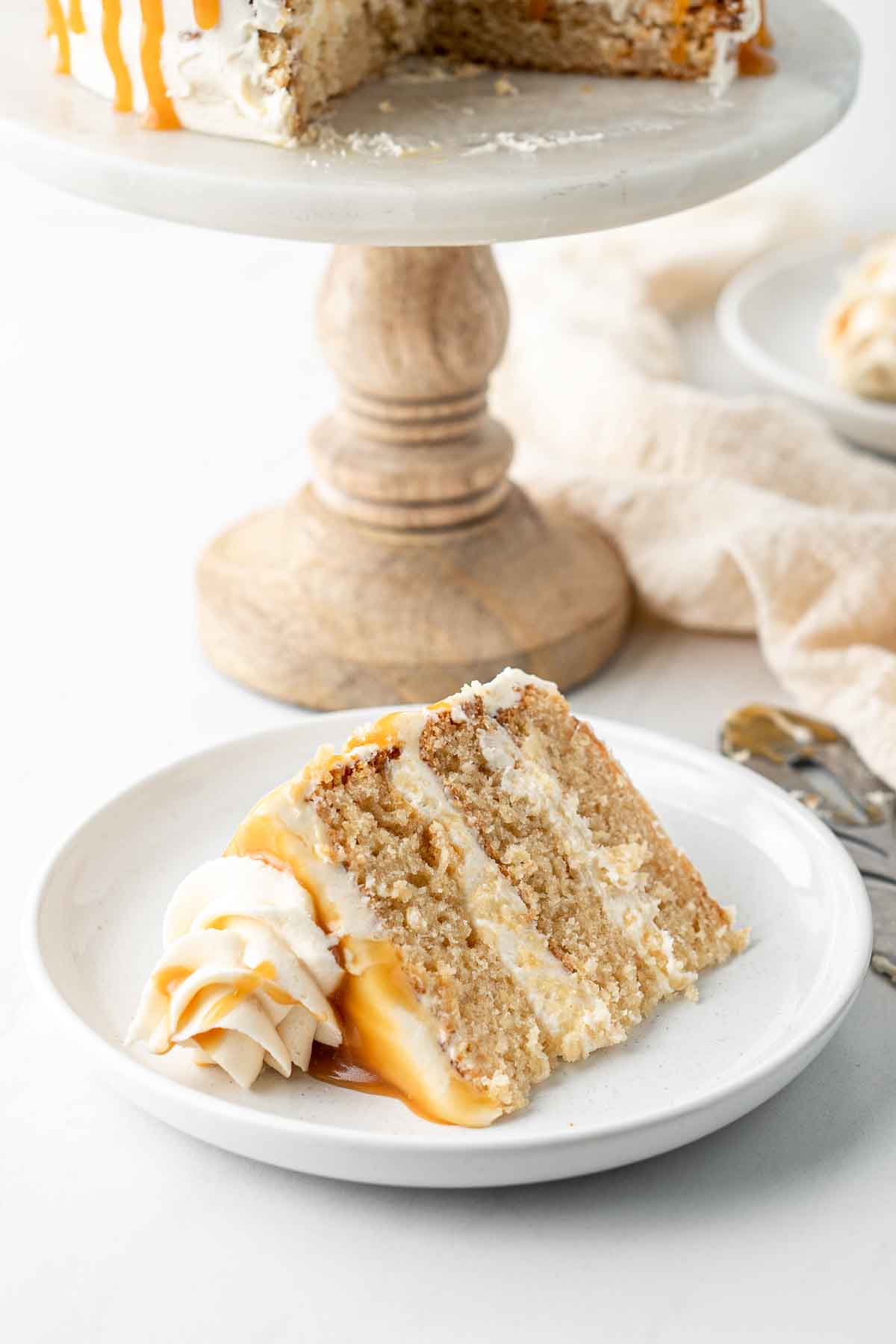
More vegan cake recipes:
Vegan Vanilla Cake
Cookies and Cream Cake (Vegan)
One Bowl Vegan Chocolate Cake
Vegan Sticky Date Pudding With Caramel Sauce
Vegan Carrot Cake
Vegan Coconut Cake
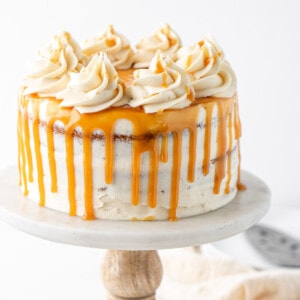
Vegan Caramel Cake
Ingredients
For the caramel cake:
- 1 cup dairy-free milk
- 1 tablespoon white vinegar
- ¾ cup white sugar
- 1 teaspoon vanilla
- ⅓ cup canola oil
- 1 ¾ cups plain flour
- 1 teaspoon baking powder
- ⅓ cup
vegan salted caramel sauce room temperature
For the caramel buttercream:
- 125 grams dairy-free butter
- ¼ cup vegan salted caramel sauce room temperature
- 4-5 cups icing sugar
- ½-1 tablespoon dairy-free milk
- ¼ cup vegan salted caramel sauce additional for drip
Instructions
- Preheat the oven to 180°C and line 3x 6 inch cake pans with cooking spray and baking paper.
- In a small bowl combine white vinegar and dairy-free milk. Set aside. In a large bowl, whisk to combine white sugar, vanilla, and canola oil.
- In a separate bowl, sift flour and baking powder and stir to combine. Add half of the dry ingredients into the wet and half of the milk mixture and whisk until combined. Add in the remainder of the dry ingredients along with the milk and again stir until mixture just comes together being careful not to overmix. Finally add in the salted caramel sauce and whisk until combined.
- Divide the batter evenly between the 3 pans and place in a preheated oven to bake for 18-20 minutes, or until the cake just springs back when lightly pressed.
- Take the cakes out of the oven and let cool in the pan for 10 minutes before turning out onto a wire rack to cool completely.
- Make the buttercream. Using a hand mixer or a stand mixer with the paddle attachment fitted, beat dairy-free butter and salted caramel sauce for 1-2 minutes until creamy. Add in 2 cups of icing sugar and beat on medium until combined. As mixture thickens, add inthe dairy-free milk as needed. Add in an additional 2 cups of icing sugar and more dairy-free milk as required until it's smooth and creamy but still thick. If frosting is too thin, add in an extra ½-1 cup of icing sugar until it reaches the right consistency.
- Decorate the cake. Place a small amount of the buttercream on a cake stand and place the first cake layer down. Add enough frosting to thickly cover the layer and add the second cake layer. Add more frosting, then the final cake layer upside down so the top of the cake is flat. Add more frosting to the top and side of the cake and use a cake scraper or knife to smooth out the edges and remove any excess frosting. This will be your crumb coat. Place the cake in the fridge for 30-60 mins to chill.
- Add another layer of buttercream to the tops and sides. Use your scraper or cake knife to smooth out the sides. Place the cake back in the fridge again to chill. Any excess frosting can be placed in a piping bag with an open star tip (I used a 1M).
- To make the caramel drip, you want to play around with the consistency of the carmel. The caramel will continue to drip down the cake more than a ganache, so you want the caramel thicker than you might expect. Leave it in the fridge to thicken up to the right consistency. I like to use a squeeze bottle for more control and carefully place a small amount of caramel at the top of the cake and watch it drip down. Once you get a feel for it, continue to move around the cake. Finally, spoon excess caramel over the top of the cake to coat the top of the cake.
- Finish the cake by piping any excess buttercream around the top. Store the cake in the fridge to help the caramel drip set.
Notes
Nutrition
Nutritional information is provided as a guide only and is calculated using automated online tools, therefore we cannot guarantee the accuracy. We encourage you to make your own calculations based on the actual ingredients used in your recipe.
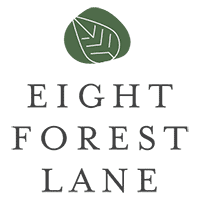

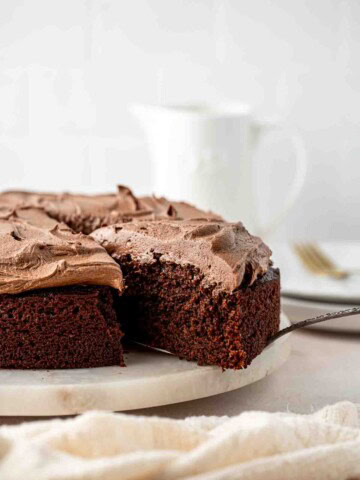
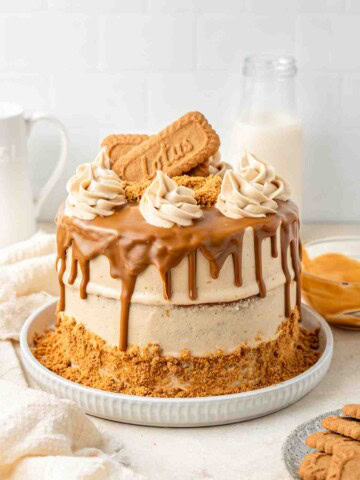
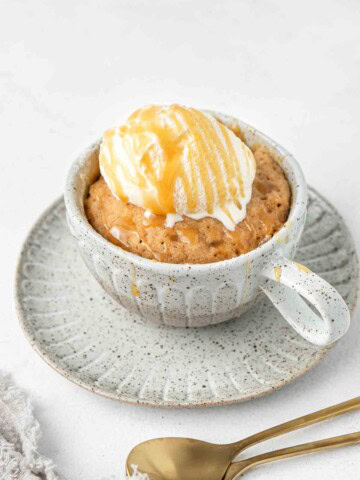
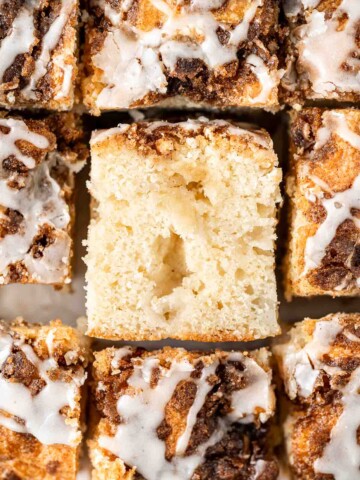
Roni Goldberg
Unless I have done something wrong the batter volume looks very small…
Sally
Hi Roni, let me know how the cake turned out for you.
Gemma
Cam the white vinegar be substituted for anything?
Sally
Hi Gemma! You could use apple cider vinegar if that’s all you had on hand, but ideally you use white vinegar as it doesn’t have a strong taste. We need the vinegar so the cake isn’t too dense but we don’t really want to be able to taste it as this cake has a delicate flavour. Thanks 🙂
Sally
What vegan butter do you use and can I make this cake chocolate?
Sally
For the vegan butter I use a product called Nuttelex Buttery as it’s the best I’ve found, but it’s an Australian product so will depend on where you are located. As for making it chocolate, I haven’t tried. You could try and replace 1/4 – 1/2 cup of flour with cocoa powder but I haven’t tested this so cannot guarantee this would work.
Linda Beuzeville
Hello, what dairy free milk do you find best for your caramel cake recipe
Sally
Hi Linda! I prefer to use oat or almond in most of my baking recipes. Thanks!